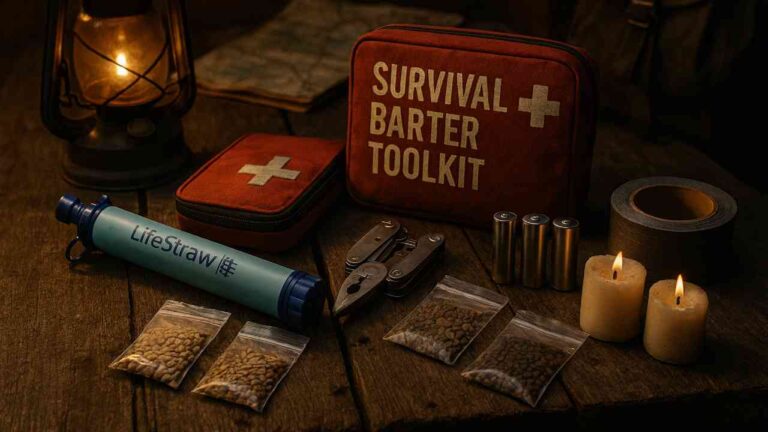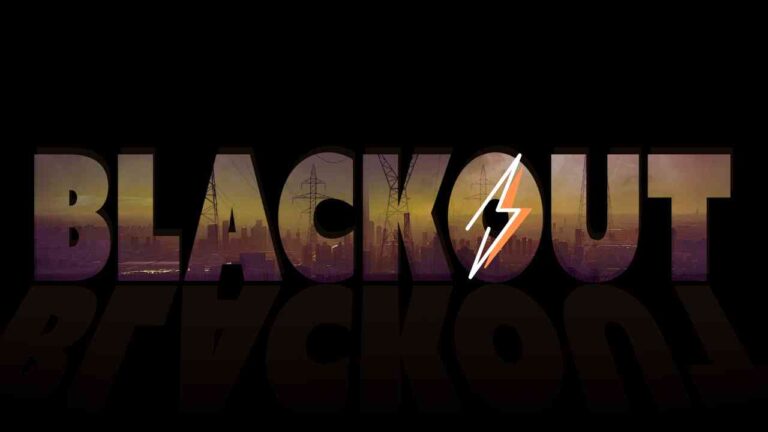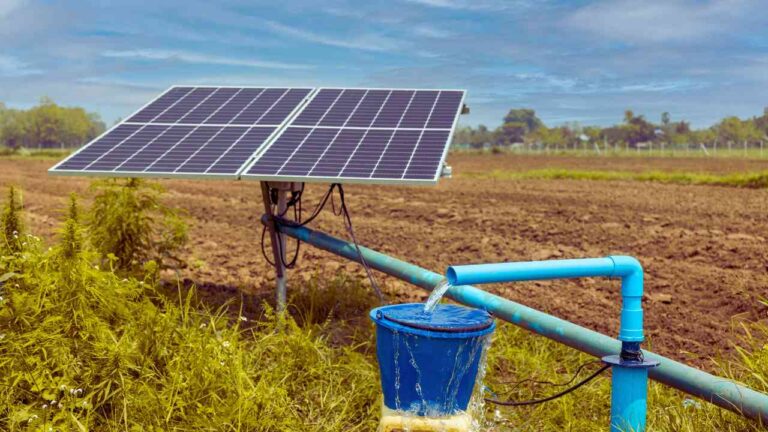Are you ready for the unexpected? Tips for Emergency food storage can mean the difference between comfort and chaos when disaster strikes. From natural calamities to unforeseen crises, being prepared with a well-stocked pantry is your first line of defense against hunger and uncertainty.
Disaster preparedness is not just about having enough food; it’s about having the right food stored properly. Long-term food storage requires careful planning and execution. Whether you’re just starting or looking to improve your existing emergency supplies, these essential tips will help you create a robust food storage system that can sustain you and your loved ones during challenging times.
Key Takeaways
- Plan for a variety of nutritious, shelf-stable foods
- Store food in cool, dry places to maximize shelf life
- Rotate your stock regularly to maintain freshness
- Include essential items like wheat, powdered milk, and salt
- Consider special dietary needs in your emergency food plan
- Aim for at least a three-day supply to start
- Supplement stored food with vitamins and minerals
Did you know that canned foods can last two years or longer? This makes them an excellent choice for your emergency food storage. However, it’s crucial to inspect your supplies regularly. Look out for signs of damage like rust, leaks, or bulges in cans. These could indicate spoilage and potential health risks.
When planning your emergency food supply, consider the nutritional needs of your household. Experts recommend storing about 240 pounds of wheat and corn per adult for a year. Don’t forget to include 75 pounds of powdered milk and 5 pounds of iodized salt. These staples form the backbone of a comprehensive long-term food storage plan.
Remember, variety is key to maintaining good nutrition during emergencies. Aim to eat at least one balanced meal each day and drink plenty of water. Including vitamin and mineral supplements in your stockpile can help ensure you’re meeting your nutritional needs when regular food sources are unavailable.
1️⃣ Understanding the Basics of Emergency Food Storage
Emergency food storage is key to being ready for anything. It keeps you fed during disasters or when the power goes out. Let’s look at the basics of storing food for emergencies.
Why Emergency Food Storage is Critical
Having enough food in an emergency can make a big difference. It keeps your family safe and fed when you can’t get to the store. It also gives you peace of mind.
“Proper emergency preparedness is not just about survival; it’s about maintaining quality of life during challenging times.”
Key Principles of Food Storage Planning
When planning your emergency food, keep these tips in mind:
- Aim for a minimum 3-day supply, with 2 weeks being ideal
- Store at least 1,500-2,000 calories per person per day
- Choose foods with long shelf lives, like freeze-dried meals
- Include a variety of foods to prevent meal fatigue
- Store in cool, dry places to maximize shelf life
Determining Your Family’s Nutritional Needs
It’s important to know what your family needs to eat in an emergency. Think about special diets, ages, and likes. Make sure to have a mix of proteins, carbs, and fats for balanced meals.
| Food Category | Examples | Shelf Life |
|---|---|---|
| Freeze-dried meals | Mountain House meals | Up to 30 years |
| Canned goods | Beans, meats, vegetables | 2-5 years |
| Grains | Rice, pasta, oats | Up to 30 years (when properly stored) |
| Comfort foods | Chocolate, coffee, tea | 1-2 years |
Remember, keeping your food in good condition and rotating it regularly is crucial. This helps it stay fresh and effective.
2️⃣ Creating Your Three-Day Emergency Food Supply
Building a strong disaster supply kit is key for short-term food storage in emergencies. Your three-day emergency food supply should include non-perishable foods. These should be easy to prepare and provide essential nutrients.
A well-planned three-day emergency food supply for one person typically includes:-
- 18-33 servings from the Bread, Cereal, Rice, and Pasta Group
- 6-12 servings from the Fruit Group
- 9-15 servings from the Vegetable Group
- 6-9 servings from the Meat, Poultry, Fish, Dry Beans, Eggs, and Nuts Group
- 6-9 servings from the Milk, Yogurt, Cheese, and other Calcium Group
When assembling your kit, choose compact, lightweight items. Include ready-to-eat canned meats, fruits, vegetables, and soups. Also, add high-energy foods like peanut butter, jelly, crackers, and trail mix. Pack these items in plastic bags to keep them dry and airtight.
The cost of a three-day emergency food supply for one adult is about $20-$35. This includes essentials like dry cereal, peanut butter, canned juice, and bottled water. Remember to adjust quantities for larger households.
Store your non-perishable foods in a cool place away from direct heat. While canned foods can last indefinitely, it’s best to use and replace them within a year. Crackers and cereals should be consumed within three months, while dried fruit and peanut butter can last up to six months. By following these guidelines, you’ll create a comprehensive disaster supply kit. This ensures your short-term food storage needs are met during emergencies.
3️⃣ Emergency Food Storage Tips
Keeping your emergency food in good shape is key. Let’s look at important tips for storing food for emergencies.
Proper Storage Conditions
Keep your emergency food in a cool, dry, and dark place. This helps keep it fresh longer. Try to keep the temperature under 75°F (24°C) for best results. Mountain House, a top emergency food provider, says their freeze-dried meals stay great for 30 years if stored right.
Temperature Control
Keeping food at the right temperature is crucial for safety. Watch your fridge and freezer during power outages. Food is unsafe if it stays between 40°F and 140°F for over two hours. Use a thermometer to check the fridge’s temperature. Remember, food stays safe in the fridge for up to four hours without power.
Container Selection and Management
Picking the right containers for your emergency food is important. Choose food-grade containers with tight lids for storing in bulk. Mountain House offers kits for different needs, from three days to a year.
For long-term storage, consider:-
- All-metal cans
- Retort pouches
- Vacuum-sealed bags
Check your containers often for damage or spoilage. Label everything with when you bought it and when it expires. This keeps your emergency food supply organized and safe.
4️⃣ Long-Term Food Storage Strategies
Planning for long-term food storage is more than just buying lots of food. You need to think about your family’s needs, what you like to eat, and where you can store food. Let’s look at good ways to store food in bulk and how to keep it fresh for a long time.
Bulk Storage Solutions
For long-term food storage, pick items that last a long time. Grains like white rice and oats can last 10-20 years if stored right. Dry foods, like beans, can last over a decade too. Store these in airtight containers like #10 cans or mylar bags with oxygen absorbers.
Rotation Systems
Using a food rotation system is very important. It helps keep your food fresh. Use the “first in, first out” rule. Label containers with what’s inside and when you got it. Put newer items behind older ones. This way, you use the older food first, saving you from waste and keeping your food fresh.
Inventory Management
Managing your food inventory well is crucial. Keep a detailed list of what you have, including when it expires. Check and update this list often. Use clear totes for easy access to your food. Make sure to store a variety of foods. Mix staples with freeze-dried and canned goods for a balanced diet.
“Building a food supply gradually prevents spoilage and food waste.”
Remember, you don’t have to give up fresh foods. You can grow your own veggies or buy from local farmers. By combining these strategies, you’ll have a strong, varied, and easy-to-manage food storage system. It will meet your family’s needs in any emergency.
5️⃣ Essential Foods for Your Emergency Pantry
Having a well-stocked emergency pantry is key for being ready. Your list should include non-perishable foods that give you energy and nutrients. Let’s look at the must-haves for a full emergency food supply. Begin with protein-rich foods like canned meats, beans, and peanut butter. These keep well and are full of nutrients. For a 2,000-calorie diet, aim for 5 1/2 ounces of protein per person daily.
Add canned fruits and vegetables for a balanced diet. Make sure you have enough for 2 1/2 cups of veggies and 2 cups of fruits per person each day. Also, include whole-grain cereals, crackers, and pasta for energy and fiber.
| Food Category | Daily Recommendation (per person) | Examples |
|---|---|---|
| Protein | 5 1/2 ounces | Canned meat, beans, peanut butter |
| Vegetables | 2 1/2 cups | Canned mixed vegetables, vegetable juices |
| Fruits | 2 cups | Canned fruits, dried fruits, fruit juices |
| Grains | 6 ounces | Cereals, crackers, pasta, rice |
| Dairy | 3 cups (fluid milk equivalent) | Powdered milk, shelf-stable processed cheese |
Don’t forget comfort foods and items for special diets. For babies, keep formula and baby food on hand. MREs are great for compact, preserved meals. And, remember to store at least one gallon of water per person per day for drinking and cooking.

6️⃣ Food Preservation Methods and Techniques
Food preservation is key for emergency readiness. Learning different techniques can make your food last longer. Let’s look at some top ways to keep your food fresh and safe.
Dehydration
Dehydrating food is a great way to keep fruits, veggies, and meats fresh. It removes moisture, which stops spoilage. You can dehydrate citrus fruits, bananas, apples, and tomatoes. Dehydrated foods can last up to five years. They’re a smart choice for your emergency food stash.
Canning Techniques
Canning is a trusted method for preserving food. It seals food in airtight containers to block bacteria. Water bath canning is good for high-acid foods like fruits and pickles. For low-acid foods, you need pressure canning. Canned goods can last for years, making them perfect for long-term storage.
Vacuum Sealing
Vacuum sealing removes air from containers, stopping spoilage and freezer burn. It’s great for keeping meats and meals fresh. It also saves space in your freezer and makes food last longer.
| Preservation Method | Best For | Shelf Life |
|---|---|---|
| Dehydration | Fruits, Vegetables, Meats | Up to 5 years |
| Canning | Fruits, Vegetables, Meats, Jams | 1-5 years |
| Vacuum Sealing | Meats, Prepared Meals | 6 months – 3 years |
Learning these preservation techniques can help you have a varied and lasting emergency food supply. Practice them before emergencies to get good at them. This way, you’ll be ready when you need to use them.
7️⃣ Special Dietary Considerations
Planning for emergency nutrition means thinking about special diets and food allergies. It’s important to make sure everyone’s needs are met. This way, your family stays healthy during tough times. When you’re stocking up, remember any dietary restrictions. For someone with celiac disease, include gluten-free foods. If there’s a diabetic in the family, pick low-glycemic options.
People with food allergies need safe alternatives. This includes avoiding common allergens like nuts or dairy. Don’t forget about age-specific needs. Infants need formula or breast milk, and the elderly might prefer softer foods or supplements.
Also, remember that emergencies are not the time to try new foods. Stick to what everyone is used to. This helps avoid serious reactions in stressful situations.
| Dietary Need | Emergency Food Options |
|---|---|
| Gluten-Free | Rice, quinoa, gluten-free crackers |
| Dairy-Free | Canned coconut milk, shelf-stable almond milk |
| Nut Allergies | Sunflower seed butter, roasted chickpeas |
| Diabetic-Friendly | Canned vegetables, sugar-free jerky |
By planning ahead and considering everyone’s special dietary needs, you can create an emergency food supply. This keeps your entire family safe and well-nourished during tough times.
8️⃣ Water Storage and Purification
In emergency situations, having clean water is key. Knowing how to store and purify water can greatly help. Let’s look at the basics of managing water during crises.
Storage Requirements
Keep at least one gallon of water per person per day for three days. For longer emergencies, aim for two weeks’ supply. Use containers that are safe for food to avoid contamination. Store water in a cool, shaded area. Keep it away from sunlight and harmful chemicals. Change the water every six months to keep it fresh.

Purification Methods
When you can’t find safe drinking water, purification is crucial. Boiling is the best way to kill harmful germs. Chemical treatments, like unscented bleach, can also disinfect water well. Filtration systems can remove harmful particles and improve taste. Learning different purification methods is important for safe drinking water in any situation.
Emergency Water Sources
Find alternative water sources before a disaster hits. Rainwater collection systems can be a big help. Natural sources like streams or lakes can also be used if treated right. Don’t forget about hidden water sources at home, like the water heater or pipes. Unopened commercial bottled water is the safest choice in emergencies.
| Water Source | Purification Method | Storage Life |
|---|---|---|
| Tap Water | Bleach Treatment | 6 months |
| Rainwater | Boiling | Immediate use |
| Bottled Water | None needed | Check expiration |
Water is vital for drinking, cooking, and staying clean. Knowing how to store and purify water ensures you’re ready for any emergency.
9️⃣ Power Outage Food Safety Guidelines
Power outages can risk your food safety. It’s key to know how to handle refrigerated foods during these times. A full freezer stays cold for about 48 hours if it’s closed. A half-full one lasts 24 hours. Your fridge keeps food cold for roughly 4 hours if it’s not opened.
During a power outage, keep freezer and fridge doors shut as much as you can. Use a thermometer to check food temperatures. Discard items above 40°F (4°C). For long outages, have a cooler and ice packs ready.
Follow these guidelines to ensure food safety:
- Use perishable refrigerated foods first, then frozen foods
- Surround milk, dairy, meats, fish, poultry, eggs, and leftovers with ice in a cooler
- Safely refreeze or cook thawed frozen food if it’s still at 40°F or below
- Throw out food that has thawed or is above 40°F
If power has been out for over 4 hours, move refrigerated perishables to a cooler with ice. Remember, when in doubt, throw it out. Your health is more important than saving a few dollars on groceries.
“Food safety is not just about avoiding waste; it’s about protecting your family’s health during unexpected events.”
By following these power outage food safety guidelines, you can minimize food waste. This helps protect your family from foodborne illnesses.
🔟 Budget-Friendly Storage Solutions
Emergency preparedness doesn’t have to be expensive. With smart planning and buying, you can create a strong food storage system without spending too much. Let’s look at ways to keep your family safe without breaking the bank.
Cost-Effective Food Options
Choose affordable, healthy foods for your emergency pantry. Rice, beans, and pasta are great choices. They’re cheap and last a long time. For a 2,000 calorie diet per person per day, you can buy a 30-day supply of rice for under $45. This is based on 2020 prices.
Storage Container Alternatives
Be creative with storage to save money. Use food-grade buckets and glass jars instead of expensive containers. For example, forty pounds of white rice can fill about a dozen canning jars for around $24. This way, you can save money and still keep your food fresh.
Buying Strategies
Smart shopping is crucial for saving money. Here are some tips:
- Buy in bulk when items are on sale
- Join a bulk-buying group or co-op for better prices
- Gradually build your supply to spread out costs
- Choose cheaper versions of foods you already eat
FEMA suggests keeping at least a three-day supply of food and water for everyone in your home. For more safety, aim for three weeks to three months of supplies. By using these budget-friendly tips, you can reach your preparedness goals without spending too much.
| Item | Cost | Calories per Day | Storage Life |
|---|---|---|---|
| White Rice (40 lbs) | $17-20 | 2,100 | Up to 30 years |
| Canning Jars (12) | $24 | N/A | Reusable |
| Bullion Cubes | Varies | Negligible | About 8 years |
⓫ Storage Space Organization and Management
Effective food storage organization is crucial for emergency preparedness. Designate a specific area for your emergency supplies in a cool, dry place. Use shelving units to make the most of vertical space, storing more items in less space. This approach to pantry management keeps everything visible and easy to access. It helps you stay organized and ready for emergencies.
Use a clear labeling system for your food storage. Label each container with its contents and expiration date. Group similar items together, like canned fruits and dried beans, to make tracking easier. Keep an up-to-date inventory list as part of your strategy. Regularly check for expired items and rotate your stock. Canned fruits and vegetables last 24 months, while dry milk products can last up to 24 months.
Consider using vacuum-sealed bags for items like rice or pasta. This reduces storage space and extends shelf life. By following these tips, your emergency food supply will stay fresh and ready when needed.
FAQs Frequently Asked Ques)
How much food should I store for emergencies?
Aim for a three-day supply of non-perishable food for short-term needs. For longer emergencies, aim for two weeks. The amount needed depends on your family size, dietary needs, and storage space.
Aim for a three-day supply of non-perishable food for short-term needs. For longer emergencies, aim for two weeks. The amount needed depends on your family size, dietary needs, and storage space.
What are the best foods to store for emergencies?
Choose nutritious, non-perishable items like canned meats and fruits. Also, include dried fruits, nuts, peanut butter, and crackers. Don’t forget powdered milk, pasta, rice, and beans. Include comfort foods and items for special diets.
Choose nutritious, non-perishable items like canned meats and fruits. Also, include dried fruits, nuts, peanut butter, and crackers. Don’t forget powdered milk, pasta, rice, and beans. Include comfort foods and items for special diets.
How can I extend the shelf life of my stored food?
Store food in cool, dry, dark places. Use containers with tight lids and rotate food regularly. Check items often for signs of spoilage.
Store food in cool, dry, dark places. Use containers with tight lids and rotate food regularly. Check items often for signs of spoilage.
What’s the best way to store water for emergencies?
Store one gallon of water per person per day. Use food-grade containers and keep them away from heat and light. Rotate water every six months and learn to purify it.
Store one gallon of water per person per day. Use food-grade containers and keep them away from heat and light. Rotate water every six months and learn to purify it.
How can I create an emergency food supply on a budget?
Start with affordable staples like rice, beans, and pasta. Look for sales and buy in bulk. Use alternative containers like food-grade buckets or glass jars.
Start with affordable staples like rice, beans, and pasta. Look for sales and buy in bulk. Use alternative containers like food-grade buckets or glass jars.
What food preservation methods are best for long-term storage?
Dehydration, canning, and vacuum sealing are effective. Each method has its own safety guidelines and equipment. Practice these before emergencies.
Dehydration, canning, and vacuum sealing are effective. Each method has its own safety guidelines and equipment. Practice these before emergencies.
How should I handle food during a power outage?
Use perishable foods first, then frozen ones. Keep doors closed to keep food cold. Use a thermometer to check food temperatures. Have a cooler and ice packs ready for long outages.
Use perishable foods first, then frozen ones. Keep doors closed to keep food cold. Use a thermometer to check food temperatures. Have a cooler and ice packs ready for long outages.
How can I accommodate special dietary needs in my emergency food storage?
Plan for allergies, intolerances, and health conditions. Include suitable alternatives for family members. Store foods and supplements for infants, elderly, or those with medical conditions.
Plan for allergies, intolerances, and health conditions. Include suitable alternatives for family members. Store foods and supplements for infants, elderly, or those with medical conditions.
What’s the best way to organize my emergency food storage?
Choose a specific area for storage and use shelving. Label items clearly with contents and expiration dates. Group similar items together and keep an inventory list. Regularly check for expired items.
Choose a specific area for storage and use shelving. Label items clearly with contents and expiration dates. Group similar items together and keep an inventory list. Regularly check for expired items.
How often should I check and rotate my emergency food supply?
Check your supply every six months. Rotate items based on expiration dates. Keep an updated inventory list to track needs.
Check your supply every six months. Rotate items based on expiration dates. Keep an updated inventory list to track needs.








[…] and portability. Aim for a 30-40 liter capacity, which is spacious enough to hold essentials like food, water, clothing, and tools without being overly bulky. Remember, a backpack that’s too heavy can […]
[…] fast. I reached for the emergency cooking tools I had stored away and used a small gas burner and canned food to prepare a warm meal. That moment made something clear—we can’t rely on electricity all the […]